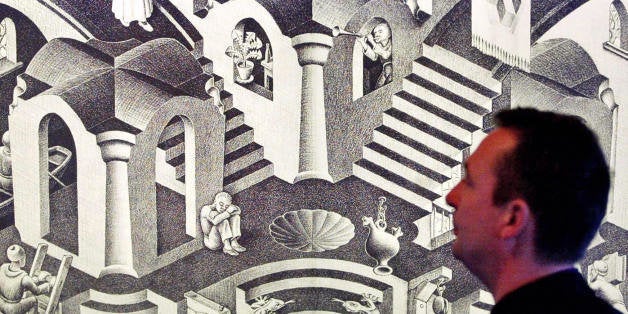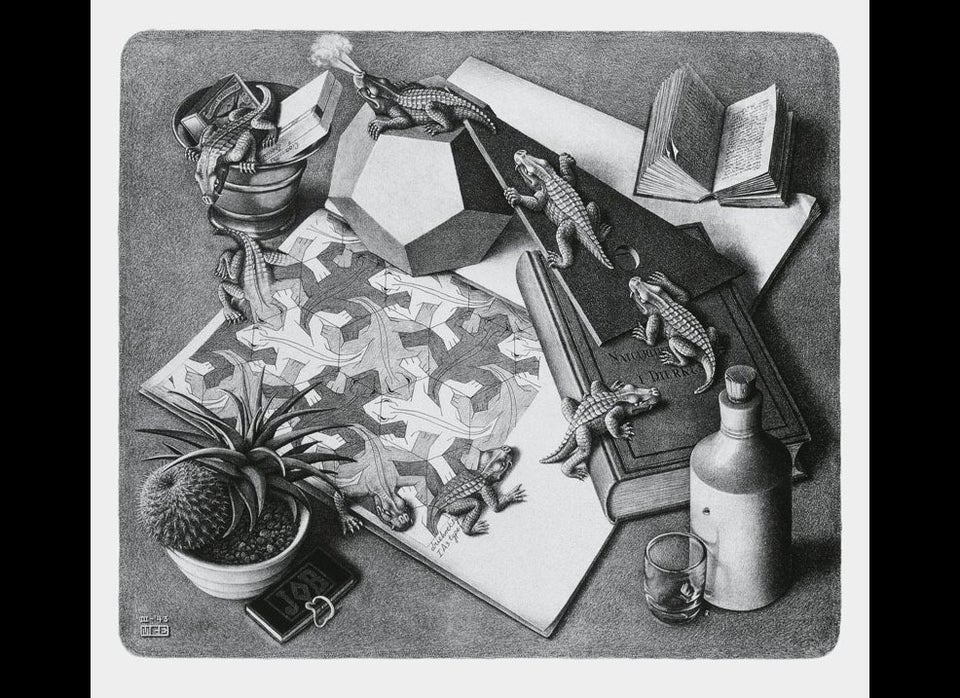
M.C. Escher is well known for his surreal, reality-warping engravings -- two hands drawing each other, infinite staircases, fish changing into birds and back again. Never an art-world celebrity, he was nonetheless beloved by everyone from counterculture youth to mystics and scientists.
As a result, his work has inspired plenty of crazy ideas about alternative realities, mysticism, and mental emancipation. And he’s been a great and humble sport about them all. Once, when a woman called him, saying, "Mr. Escher, I am absolutely crazy about your work. In your print ‘Reptiles’ you have given such a striking illustration of reincarnation,” he responded simply: “Madam, if that's the way you see it, so be it.”
He eventually elaborated: "In my prints, I try to show that we live in a beautiful and orderly world and not in a chaos without norms, as we sometimes seem to."
To commemorate Escher's birthday on Wednesday, and decades of Escher mythologizing, we offer you five mind-bending factoids on his life, influences, and legacy -- that are actually true. Behold:
1. He was not a mathematician -- in fact, he wasn't even a good math student.
Contrary to popular belief, Escher had little background in or talent for math. In fact, he had poor grades, failed his high school exams, and dropped out of architecture school to study decorative arts.
That all changed 15 years later when he read a paper by George Pólya on “plane symmetry groups," repetitive patterns on two-dimensional surfaces. The paper inspired his work for decades to come, though Escher admits he understood little of the mathematical theory behind it.
As his interest in geometries developed, Escher would study topology, work with H.S.M. Coxeter on tessellations, and form a lasting collaboration with Roger Penrose that explored mathematically impossible forms -- which inspired his canonical “Ascending and Descending.”
2. He started out by drawing landscapes and animals.
Before his hands were drawing hands drawing hands, Escher developed a penchant for scenery. A trip through Italy in the early 20s imprinted the landscape on his mind, and he spent many years on representational art of its countryside.
The best-known example is “Castrovalva,” an early lithograph that generated positive critical response, but others like “Atrani, Coast of Amalfi” and “The Bridge” are similarly stunning. “Dolphins” and “Phosphorescent Sea” show an early preoccupation with aquatic forms and light.
Castrovalva, AbruzziFebruary 1930 LithographEscher embarked on a trip through Abruzzi in spring 1929, with the idea...
Posted by M. C. Escher on Wednesday, March 28, 2012
3. He had a revelation when looking at Moorish art.
Escher’s work took a radical turn after a 1936 voyage through the Mediterranean and a visit to The Alhambra, an Islamic palace in Granada, Spain. The geometric, fractal-like patterns in Moorish art inspired him to depart from landscapes and work with interlocking patterns instead of discrete objects -- a style seen in the series “Regular Division of the Plane” and “Sky and Water,” among other works. Many people assume those structures began with Escher’s interest in math, but they were actually first motivated by copying, then developing, the aesthetics of The Alhambra. The mathematical theory behind the patterns came later.
On top of this, while Moorish art and the complex math behind it are commonly seen as the main inspirations for Escher, he may have also drawn from Japanese woodblock prints. Hokusai’s "Fuji from the Sea" and “The Great Wave off Kanagawa” feature a strikingly similar optical illusion to “Sky and Water I" and "II," in which birds turn into ocean water. If the connection seems far-fetched, remember that Hokusai’s work was all the rage in Europe’s art scene in the second half of the 19th century. So even if Escher did not consciously copy the style, he very likely was exposed to the prints.
4. His work has made secret Hollywood appearances.
Escher’s works have inspired plenty of alternative universes, but two of his more prominent "appearances" occur in Middle Earth and Christopher Nolan's dreamscapes. Yes, the design for the Mines of Moria in the "Lord of The Rings" trilogy film adaptations was likely inspired by "Procession in Crypt," and there were originally plans for even more direct references. A cut scene from "The Two Towers" movie featured an endless staircase modeled directly on "Relativity."
“Inception,” too, made use of infinite staircases and impossible buildings within its dreamworlds. “Shall we take a look at some paradoxical architecture?” asks Arthur as he coaches Ariadne into building a mutated, six-sided Paris. Nolan has cited Escher as an inspiration, which is fitting, since Escher, when asked about potential substance-use, once said: “I don't use drugs, my dreams are frightening enough.”
Procession in CryptJuly 1927 Woodcuthttps://www.facebook.com/photo.php?fbid=10151189765268200&l=53632e4b8d
Posted by M. C. Escher on Sunday, October 13, 2013
5. He almost designed the currency for the Dutch Central Bank.
In 1950, De Nederlandsche Bank held a competition to create new guilder banknotes, and Escher sent a series of sketches. In addition to his characteristic illusions and geometric designs, his banknotes featured the scientist Van Leeuwenhoek, a founder of modern microbiology.
Sadly, the designs were rejected for being "too ornate" -- yet another example of the world misunderstanding Escher.
De Nederlandsche Bank had its banknotes printed by the printing firm Joh. Enschedé en Zonen in Haarlem. From 1950 Escher...
Posted by M. C. Escher on Saturday, May 26, 2012
Correction: This article previously stated that Escher studied typology. He did, in fact, study topology.

